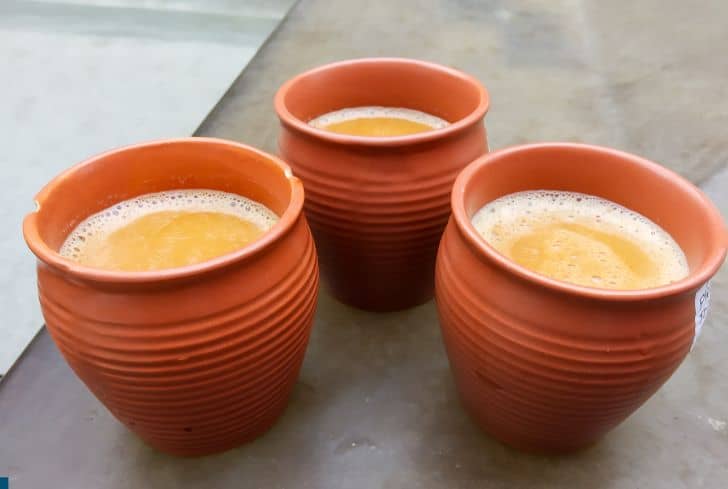Is Terracotta Food Safe? (For Cooking, Heating, and Storing)
Terracotta pots aren’t as popular as other stoneware in the kitchen, but they are an attractive cookware option for some people for an earthy color and interesting look.
Terracotta pots designed and manufactured for cooking and storing food are considered food safe and non-toxic. However, terracotta pots designed for holding plants or painted to be used as decorations are not food safe and should never be used for cooking because of the risk of toxic contamination.
If you are concerned about the possibility of toxicity, it is best to check with the manufacturer or retailer before purchasing a pot.
Are Terracotta Pots Food Safe for Cooking?
Note that for this article we will always be talking about terracotta pots that were specifically designed to be used to cook and store food.
Terracotta pots that were designed to cook and storage food are safe for cooking, particularly broiling and baking. Terracotta is a type of clay fired at a high temperature, making it very strong and durable. It is also non-porous, so it won’t absorb flavors or odors from food. Additionally, terracotta pots are very good at evenly distributing heat, which makes them ideal for cooking.
However, terracotta pots that were not designed for cooking – decorative terracotta pots or terracotta pots designed to hold plants, are NOT food safe. Terracotta pots that have a glaze CAN cause harm and should be a health concern. These glazes can leach heavy metals such as lead or cadmium.
So, if you’re looking for a safe and healthy way to cook your food, terracotta pots are a great option. Just be sure to follow the manufacturer’s instructions for care and use. And, if you have any questions or concerns, please consult the manufacturer for advice.
Are Terracotta Pots Toxic?
No, terracotta pots designed for cooking are not toxic and, therefore, safe for cooking and eating (but not advisable).
However, it is essential to note that some glazes or paints used on decorative terracotta pots may contain lead, which can be toxic if ingested.
Always check with the manufacturer before using a glazed or painted terracotta pot for cooking or eating purposes. Additionally, you’ll need to take extra care when preparing food in terracotta pots, as they can absorb flavors and odors from whatever was cooked in them previously.
Terracotta pots can be a safe and healthy cooking option when used correctly. However, it’s always best to consult with the manufacturer before using any pot, whether it’s terracotta or not, for cooking purposes.
Are Terracotta Pots Microwave Safe?
Yes, some terracotta pots made today are microwave-safe. Check the bottom of the pot for a symbol that looks like a microwave oven with wavy lines above it — if you see this symbol, it means the pot can go in the microwave —if there’s no symbol, assume the pot is not safe to use in the microwave.
Terracotta pots are also oven-safe, so if you want to cook something in your oven inside a terracotta pot, that’s usually fine. Just be aware that the pot will become very hot, so use oven gloves when you remove it from the oven. And as always, ensure plenty of ventilation in your kitchen when cooking with terracotta pots.
One more thing to keep in mind about terracotta pots is that they’re not dishwasher-safe, so if you use one, wash it by hand.
What Can You Cook in Terracotta Pots?
You can cook almost anything in a terracotta pot. The porous nature of the clay allows it to absorb flavors, making it ideal for slow-cooked dishes.
And the pots can be used on the stovetop, in the oven, or even on the grill. Just be sure to soak the pot in water for 30 minutes before cooking and to avoid using it for acidic dishes. Below are a few things you can cook in terracotta pots:
- Vegetable ragouts: Sauté your favorite vegetables in a terracotta pot with some olive oil. Then add some broth and stew until the vegetables are cooked through.
- Braised meats: Season your meat of choice with salt and pepper. Brown it in a terracotta pot, then add some broth or wine and braise until the meat is cooked through.
- Soups: There’s nothing better than a hearty soup on a cold day. And you can make one right in your terracotta pot. Just sauté some vegetables, then add broth and your favorite seasonings. Let it simmer until everything is cooked through.
- Baked potatoes: Who doesn’t love a baked potato? And you can make them right in your terracotta pot. Just preheat the oven to 400 degrees. Then, prick your potatoes with a fork and rub them with olive oil. Place them in the pot and bake for about 45 minutes, or
- Whole chickens: Yes, you can even bake a whole chicken in a terracotta pot. Just rub the chicken with some olive oil and your favorite seasonings.
- Lasagna: One of the best things about lasagna is that it tastes even better as leftovers. And you can make it right in your terracotta pot.
What is the Difference Between Terracotta And Clay Pots?
Terracotta and clay pots are both made of natural materials, but they have some key differences.
What is Terracotta?
Terracotta is a type of earthenware, a ceramic category containing clay but not vitrified or hardened by heat. It is made by first mixing clay and water together to create a malleable paste.
The paste is then shaped into the desired form and left to air dry, which can take several days or weeks.
Once the terracotta pot is completely dry, it is fired in a kiln at a low temperature. This “bisque firing” makes the pot stronger and less likely to break when exposed to moisture.
What are Clay Pots?
A clay pot is made of natural materials and have been used for centuries to grow plants and store food. They are typically unglazed, which avoids potential contaminants.
You can choose from many different types of pottery, but two of the most popular choices are terracotta and clay pots. Both of these materials have unique benefits and drawbacks, so it’s important to know the difference before making a purchase.
Terracotta pots are made from fired clay, making them much more durable than regular clay pots. They’re also less likely to crack or chip and can withstand high temperatures. However, terracotta pots are also more expensive than clay pots.
Clay pots are made from raw, unfired clay. They’re less durable than terracotta pots and more likely to crack or chip. However, they’re much cheaper than terracotta pots.
So, which type of pot is right for you? It depends on your needs and preferences. Terracotta is the way to go if you’re looking for a durable, long-lasting pot. If you’re on a budget or you have plants that prefer cooler temperatures, then clay pots are a great choice.
Do some research and decide which type of pot is best for your needs.

Do Clay Pots Leach Chemicals?
No, clay pots are non-reactive, meaning there’s nothing that can leach when preparing your meals. When compared to other materials like plastics, which can release harmful chemicals into food and water, clay is a safer option.
Let Us Know How We’re Doing!
Did this expertly prepared resource answer your question?
Do you have another question about home maintenance, home improvement projects, home appliance repair, or something else?
Get more information, send in questions and keep the discussion going by contacting the I’ll Just Fix It Myself company customer service team at at 1-800-928-1490 or Email us at [email protected]
